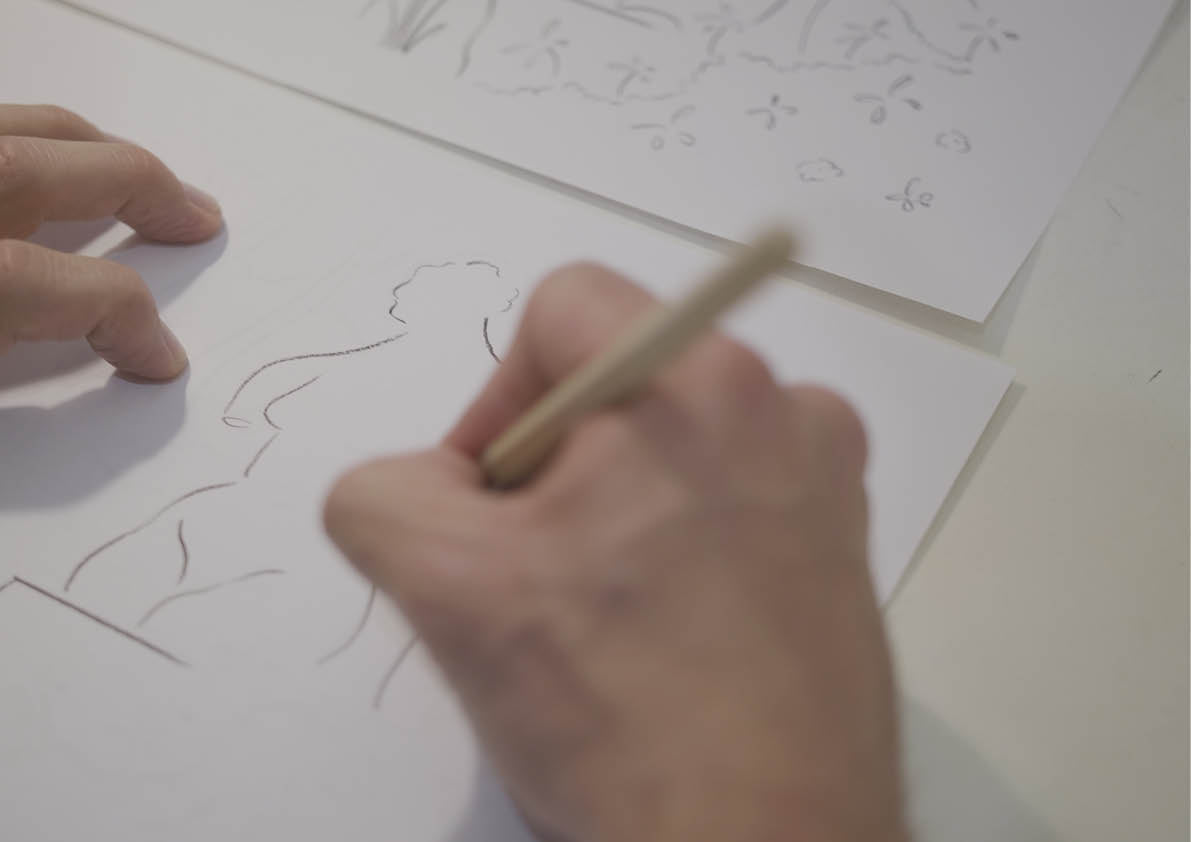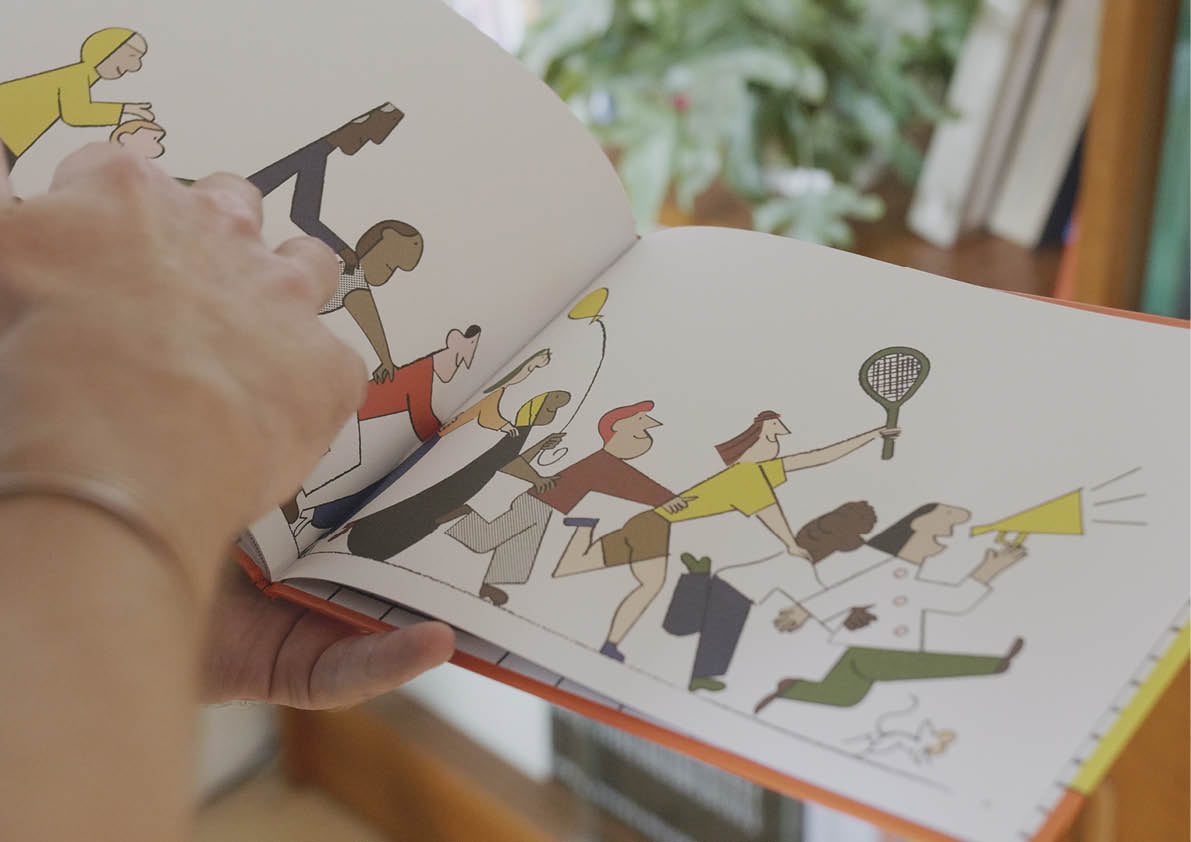
This season we are exploring A Creative Practice. In the hope of prompting creativity, we asked six illustrators to create an unfinished drawing on a postcard. We're now inviting you to complete the drawing, in whatever way you'd like, and to send the postcard back to TOAST. You can request your own postcard and find out more about A Creative Practice here.
All of the illustrators we collaborated with have a unique way of working - we spoke to them about this and their own relationship with creativity...

Charlotte Mei works in a studio under the railway arches in Brixton. She shares the space with 10 other artists and illustrators. Her small studio is full of colour pots of paint, jars of brushes, postcards and trinkets brought back from her travels. She paints with a minimal palette of muted, matte colours. The visible presence of the brush strokes in each piece lends her work a certain painterliness, but the bold shapes and abstract elements give it modernity and a fresh, joyful naivety.
Each day begins with a walk through Camberwell park, along with her dog Monkey. The first thing she does when sitting at her desk is to write a list this helps her shape the day. On a rare, free afternoon, she visits the British Museum. Sketchbook in hand she'll wonder through the collections, choosing certain themes: sometimes it's figures, sometimes pottery or a certain geographical location. She says she stops working as soon as something looks nearly finished. You can always add more but it's harder to pull back on a piece that you've overworked.


Nicolas Burrows works in a studio in Hackney with two other illustrators. It's a beautiful, high-ceilinged studio, and despite its proximity to the bustling high street, feels calm. Works-in-progress, prints by Supermarche, Espen Friberg and Nathaniel Russel are pinned to his walls. Nicolas works primarily with collage, creating brightly coloured, abstract and figurative compositions, influenced by modernist design.
He says he knows if something is finished when it just sings. But on days when he finds himself at a creative loss, he likes to walk; it might be a meandering walk to the shop or a full day of hiking. It's the rhythm of the walking that helps thoughts flow more freely, he says. He also has an aversion to tidiness. Keeping tidy seems to prevent my brain from loosening up and just doing stuff, he says. I find it creatively paralysing that fear of the blank page and all that There's satisfaction in creating order our of chaos, not more order out of order.


David Doran works in a studio in Falmouth, Cornwall. He works with his wife Izzy, who is also his studio manager. The studio is a five minute cycle along the river from their home and houses nine other artists, including David's painter brother, Jon. It's such a nice community to be in, he says, there are photographers, ceramicists, printmakers, and we often pop into each other's spaces to see what we've been working on. David's style is incredibly distinctive working with an ink brush pen and a refined colour palette he creates simple, iconic images, with a nod to vintage travel posters.
Each day begins with the radio, coffee and exercise beginning the day actively helps wake the mind. Izzy manages the deadlines and project briefs so that David can begin drawing as soon as possible. Podcasts from Marc Maron and Adam Buxton can often be heard in the background. Minimalism is another important factor messiness can be overwhelming, he says, particularly with a ton of deadlines. And every evening he clears his desk completely, ready for the day ahead. If he finds himself in a creative slump, he'll reach for his guitar or if it's summer time go for a dip in the sea. This summer, we've swum most days of the week. Diving into the sea on a swelteringly hot day is a wonderful feeling.


Charlotte Trounce works in a large, light filled studio in South Bermondsey. She shares the space with two set designers and the radio is always on currently tuned to a French radio station called Fip. Her desk is well-ordered and uniform, contrasting with the rest of the studio, which is often filled with props, saws and a lot of dust. Paintings and postcards are pinned up on her walls Matisse, Picasso, still life photographs by Jasper Morrison and there are piles of neatly stacked books, from children's story books to gallery catalogues.
Charlotte's work is gestural and painterly a mixture of loosely painted landscapes, ink drawn portraits and abstract marks. Everyday objects and architecture inspires her. But it's travel that really sets her creativity alight. She recently came back from a residency in Japan and found the landscapes there captivating. But it's hard to be creative all the time, and some days, she says, she spends hours simply staring at her sketchbook, with nothing feeling right. It's times like these that are incredibly frustrating, but she's learning to let them pass. If you can't make it work, better to just go out of the studio and do something else entirely! More often than not, it'll all come together the next day.


William Luz works in Bristol a city he has just moved to with his wife and baby boy. His work ranges from beautifully loose line drawings of figures to bold, colourful shapes, with hints of Matisse. The arrival of the baby has disrupted his regular routine somewhat, but each day begins with a quick drawing in a sketchbook, to switch that part of my brain on, he says. Music is a constant backdrop to his work, if there's no music, my mind will wonder. Sometimes it's ambient, or abstract rhythmical music, other times it's something he knows and loves it all depends on how stimulated he needs to be.
If he's looking for inspiration, he'll visit local libraries or museums and archives drawing in a new environment instead of the studio really helps. With a new baby, time has become incredibly precious and days wasted or fruitless can be galling. But, he says, it's important to work through the failures it's the failures that can result in new ideas and outcomes.

Jay works from his studio in Hastings. His works mostly bold, graphic line drawings in ink are full of character and humour. Mornings are the best time for Jay and drawing begins almost as soon as he wakes up. He has the quickest of breakfasts just a fruit smoothie so as not to delay. If he works late into the evening his head will be spinning. He needs several hours to fully unwind and separate himself from the creative process.
Tidiness is also important. If there is too much mess, or too many things in his peripheries he can be easily distracted. I become flooded with ideas or possibilities; keeping my desk clear keeps me focussed.
He likes to play around with whatever materials he can lay his hands on. He recently moved and has been carving images into polystyrene packaging, like old stone carvings.

What really helps is if you can manage to do things without caring what others think of it, he says, which really isn't easy and I can't fully embrace it myself just yet. So I make a mix of both. I make things that are just nonsense and that I enjoy making, but which I'm aware others might not appreciate in the same way. And other things which I know or hope people will connect with. Over time, he says, you find a sort of confidence and comfort in making.
Images by Rory Gibson.
Be a part of A Creative Practice.

Add a comment